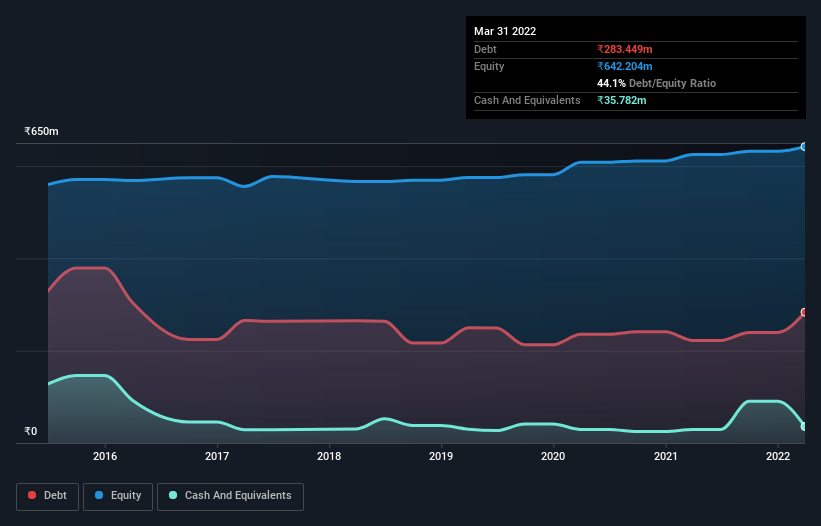Somi Conveyor Beltings (NSE:SOMICONVEY) Has A Somewhat Strained Balance Sheet

Warren Buffett famously said, 'Volatility is far from synonymous with risk.' It's only natural to consider a company's balance sheet when you examine how risky it is, since debt is often involved when a business collapses. As with many other companies Somi Conveyor Beltings Limited (NSE:SOMICONVEY) makes use of debt. But is this debt a concern to shareholders?
What Risk Does Debt Bring?
Debt and other liabilities become risky for a business when it cannot easily fulfill those obligations, either with free cash flow or by raising capital at an attractive price. If things get really bad, the lenders can take control of the business. However, a more common (but still painful) scenario is that it has to raise new equity capital at a low price, thus permanently diluting shareholders. Having said that, the most common situation is where a company manages its debt reasonably well - and to its own advantage. When we think about a company's use of debt, we first look at cash and debt together.
See our latest analysis for Somi Conveyor Beltings
What Is Somi Conveyor Beltings's Debt?
You can click the graphic below for the historical numbers, but it shows that as of March 2022 Somi Conveyor Beltings had ₹283.4m of debt, an increase on ₹222.1m, over one year. On the flip side, it has ₹35.8m in cash leading to net debt of about ₹247.7m.

How Healthy Is Somi Conveyor Beltings' Balance Sheet?
The latest balance sheet data shows that Somi Conveyor Beltings had liabilities of ₹375.2m due within a year, and liabilities of ₹52.3m falling due after that. Offsetting these obligations, it had cash of ₹35.8m as well as receivables valued at ₹230.6m due within 12 months. So its liabilities outweigh the sum of its cash and (near-term) receivables by ₹161.1m.
This deficit isn't so bad because Somi Conveyor Beltings is worth ₹389.9m, and thus could probably raise enough capital to shore up its balance sheet, if the need arose. But it's clear that we should definitely closely examine whether it can manage its debt without dilution.
We measure a company's debt load relative to its earnings power by looking at its net debt divided by its earnings before interest, tax, depreciation, and amortization (EBITDA) and by calculating how easily its earnings before interest and tax (EBIT) cover its interest expense (interest cover). Thus we consider debt relative to earnings both with and without depreciation and amortization expenses.
While Somi Conveyor Beltings's debt to EBITDA ratio (3.9) suggests that it uses some debt, its interest cover is very weak, at 1.7, suggesting high leverage. So shareholders should probably be aware that interest expenses appear to have really impacted the business lately. More concerning, Somi Conveyor Beltings saw its EBIT drop by 7.1% in the last twelve months. If that earnings trend continues the company will face an uphill battle to pay off its debt. When analysing debt levels, the balance sheet is the obvious place to start. But you can't view debt in total isolation; since Somi Conveyor Beltings will need earnings to service that debt. So when considering debt, it's definitely worth looking at the earnings trend. Click here for an interactive snapshot.
Finally, a business needs free cash flow to pay off debt; accounting profits just don't cut it. So the logical step is to look at the proportion of that EBIT that is matched by actual free cash flow. Looking at the most recent three years, Somi Conveyor Beltings recorded free cash flow of 20% of its EBIT, which is weaker than we'd expect. That's not great, when it comes to paying down debt.
Our View
We'd go so far as to say Somi Conveyor Beltings's interest cover was disappointing. But at least its level of total liabilities is not so bad. Looking at the bigger picture, it seems clear to us that Somi Conveyor Beltings's use of debt is creating risks for the company. If all goes well, that should boost returns, but on the flip side, the risk of permanent capital loss is elevated by the debt. The balance sheet is clearly the area to focus on when you are analysing debt. However, not all investment risk resides within the balance sheet - far from it. These risks can be hard to spot. Every company has them, and we've spotted 2 warning signs for Somi Conveyor Beltings (of which 1 is significant!) you should know about.
When all is said and done, sometimes its easier to focus on companies that don't even need debt. Readers can access a list of growth stocks with zero net debt 100% free, right now.
New: Manage All Your Stock Portfolios in One Place
We've created the ultimate portfolio companion for stock investors, and it's free.
• Connect an unlimited number of Portfolios and see your total in one currency
• Be alerted to new Warning Signs or Risks via email or mobile
• Track the Fair Value of your stocks
Have feedback on this article? Concerned about the content? Get in touch with us directly. Alternatively, email editorial-team (at) simplywallst.com.
This article by Simply Wall St is general in nature. We provide commentary based on historical data and analyst forecasts only using an unbiased methodology and our articles are not intended to be financial advice. It does not constitute a recommendation to buy or sell any stock, and does not take account of your objectives, or your financial situation. We aim to bring you long-term focused analysis driven by fundamental data. Note that our analysis may not factor in the latest price-sensitive company announcements or qualitative material. Simply Wall St has no position in any stocks mentioned.
About NSEI:SOMICONVEY
Somi Conveyor Beltings
Manufactures and sells industrial conveyor belts in India.
Flawless balance sheet with solid track record.
Similar Companies
Market Insights
Community Narratives




